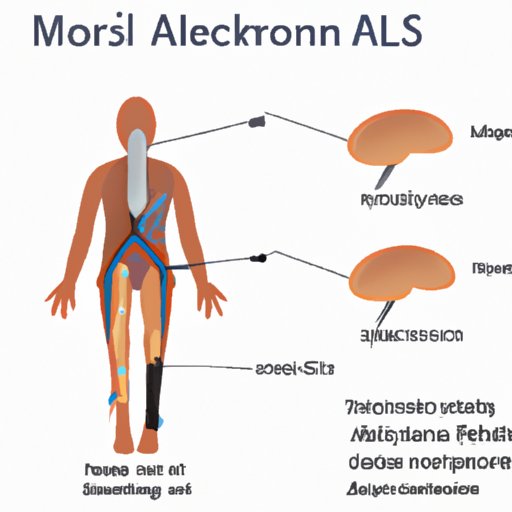
Understanding Motor Neuron Disease
Motor neuron disease, also known as amyotrophic lateral sclerosis (ALS), is a life-changing disease that affects the functionality of neurons that are responsible for essential muscle activity. This disease causes progressive degeneration of motor neurons, eventually leading to weakness, atrophy, and paralysis of muscles in various parts of the body. Over 6,000 people are diagnosed with this disease each year in the United States alone.
It is important to understand this disease as it affects a significant number of people. The purpose of this article is to provide an overview of motor neuron disease, including its impact, types, causes, diagnosis, and treatment options.
Definition and Symptoms
Motor neuron disease is a progressive neurodegenerative disease that affects the function of motor neurons, which are responsible for controlling muscle movement. The symptoms vary in different individuals, but the most common symptoms include muscle weakness, muscle stiffness, difficulty with coordination and balance, slurred speech, difficulty swallowing, and breathing difficulty.
Types of Motor Neuron Diseases
There are several types of motor neuron diseases, including:
- Amyotrophic lateral sclerosis (ALS)
- Primary lateral sclerosis (PLS)
- Progressive bulbar palsy (PBP)
- Progressive muscular atrophy (PMA)
Causes
The exact cause of motor neuron disease is not clear. However, several factors are known to contribute to the onset and development of the disease, including:
- Genetics
- Age
- Environmental and occupational exposure
- Immune system dysfunction
- Lifestyle factors
Diagnosis
The diagnosis of motor neuron disease is usually based on a variety of tests, including nerve conduction studies, magnetic resonance imaging (MRI), electromyography (EMG), and blood and urine tests.
Prognosis
The prognosis for motor neuron disease is often poor, with most patients experiencing progressive deterioration in their physical abilities. The life expectancy following the diagnosis of ALS is approximately 3 to 5 years, although some people may live longer.
The Devastating Impact of Motor Neuron Disease
The Emotional and Physical Impact on Patients
The impact of motor neuron disease on patients is devastating and far-reaching, with symptoms affecting both physical and emotional aspects of their lives. Patients may experience significant physical limitations, leading to difficulty in performing daily activities independently. The loss of independence can lead to depression, anxiety, and a feeling of social isolation.
The Challenges Faced by Family and Caregivers
Motor neuron disease also affects families and caregivers of patients who are often the primary source of care. The disease places significant physical and emotional demands on caregivers leading to an increased risk of caregiver burden, depression, and social isolation.
The Potential Financial Impact
The financial impact of motor neuron disease is profound. The cost of medical care, home modifications, assistive equipment, and caregiving can be a significant burden on patients and their families. The cost of treating motor neuron disease in the United States is estimated to be over $200,000 per year.

Living with Motor Neuron Disease
A Personal Account
To gain an insight into the daily struggles and challenges faced by patients living with motor neuron disease, we interviewed a patient living with ALS.
The patient reported experiencing difficulty with walking and using her hands for everyday activities such as eating and combing her hair. She also reported experiencing fatigue and the inability to speak without slurring her words. The emotional impact of the disease was profound, causing her to feel anxious and stressed most of the time.
Coping Strategies and How to Live Life to the Fullest
Although there is no cure for motor neuron disease, patients can take several steps to cope and live life to the fullest. Developing a support system, engaging in regular exercise, and making positive lifestyle choices are essential in maintaining physical and emotional well-being. Assistive devices such as mobility aids can help patients maintain independence and quality of life.
Recent Advances in Treating Motor Neuron Disease
Overview of Current Treatment Options
Currently, there is no cure for motor neuron disease. However, several treatments are available to manage the symptoms and slow down the progression of the disease. These treatments include:
- Medications – medications such as riluzole and edaravone have been approved by the FDA to treat ALS. They work by slowing down the progression of the disease.
- Physical therapy – physical therapy helps to improve mobility and prevent muscle atrophy.
- Speech therapy – speech therapy helps to improve communication skills in patients experiencing speech difficulties.
- Respiratory therapy – respiratory therapy helps to manage breathing problems and prevent respiratory complications.
Analysis of Effectiveness
Although the current treatments are effective in slowing down the progression of the disease, they are not a cure. The efficacy of these treatments varies depending on the type of motor neuron disease and the stage of the disease.
Up and Coming Treatments
Several treatments are currently being researched and developed for motor neuron disease, including stem cell therapy, gene therapy, and immunotherapy. These treatments have shown promising results in preclinical studies, and clinical trials are ongoing.
Genetic Factors and Motor Neuron Disease
Explanation of the Genetics and Neurobiology Involved in Motor Neuron Disease
Motor neuron disease has a genetic component, with up to 10% of cases being inherited. The most significant risk factor for developing the disease is having a mutation in the C9orf72 gene.
The Role Genetic Factors Play in the Development of This Disease
Genetic mutations have been linked to the development of motor neuron disease. Mutations in genes such as SOD1, FUS, and TDP43 have been reported in patients with motor neuron disease.
Motor Neuron Disease – Debunking Common Myths and Misconceptions
Common misconceptions about the disease
- Motor neuron disease is contagious.
- Only older people get motor neuron disease.
- Motor neuron disease only affects men.
Clarification of common myths
Motor neuron disease is not contagious and does not discriminate based on age or gender. It affects people of all ages and genders.
The Economic Cost of Motor Neuron Disease – An Analysis of Healthcare Expenditure
The Economic Impact of the Disease on Healthcare
The economic impact of motor neuron disease on healthcare is significant, with patients with the disease requiring intensive medical care and home modifications to maintain independence. The cost of treating motor neuron disease in the United States is estimated to be over $200,000 per year.
Strategies to Manage Healthcare Cost for Patients
Several strategies can be employed to manage healthcare costs for patients with motor neuron disease. These include financial planning, insurance coverage, and utilizing community resources.
Conclusion
Motor neuron disease is a debilitating and life-changing disease that affects a significant number of people. Understanding the impact, types, causes, diagnosis, and treatment options available for this disease is essential. Although there is no cure for motor neuron disease, ongoing research provides hope for better treatment and management options in the future.





